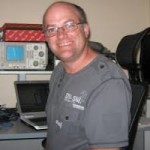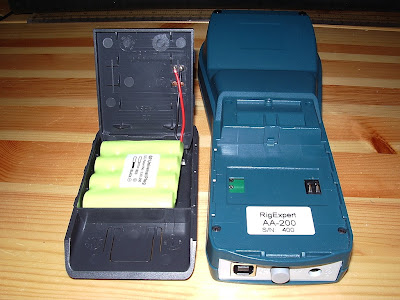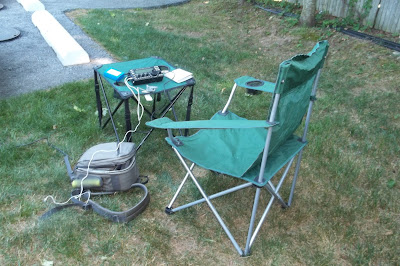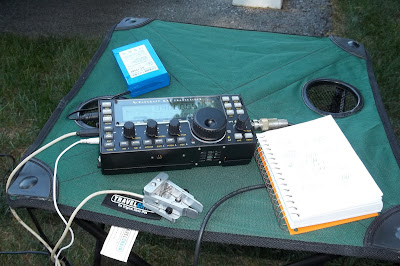Posts Tagged ‘batteries’
 LHS Episode #138: Being David Rowe
LHS Episode #138: Being David Rowe
 How about that: It's the first episode of Linux in the Ham Shack for 2015! We hope everyone is having a great new year so far. In this episode, we talk with David Rowe, VK5DGR, of Adelaide, South Australia. David is an audio engineer, Ph.D. scholar, inventor of Codec2 and co-author of FreeDV, among his many accolades. We talk to David about his projects, Linux, amateur radio, life in Australia, LinuxConf AU, the new SM1000 FreeDV device, the amount of energy it takes to make a Krispy Kreme donut, home built electric cars, and much more. Until next time...
How about that: It's the first episode of Linux in the Ham Shack for 2015! We hope everyone is having a great new year so far. In this episode, we talk with David Rowe, VK5DGR, of Adelaide, South Australia. David is an audio engineer, Ph.D. scholar, inventor of Codec2 and co-author of FreeDV, among his many accolades. We talk to David about his projects, Linux, amateur radio, life in Australia, LinuxConf AU, the new SM1000 FreeDV device, the amount of energy it takes to make a Krispy Kreme donut, home built electric cars, and much more. Until next time...
73 de The LHS Guys
 Battery problems and a solution
Battery problems and a solution
My Chinese Li Ion battery “ol’ Blue” (upper right) has given up the ghost, much the same as Mike VE3WDM has written over at his blog. In my case, the battery will not take a charge. The output from the wall wart charger is perfect, but no matter how long it’s connected to the battery, the battery itself will not charge.
I suspect either a faulty cell or perhaps a fault with the little regulator board that’s inside the blue shrink wrap. So the decision had to be made. Even though the price is relatively cheap, do I buy another Chinese battery or try something else? Do I go back to hauling around my small, but heavy, 5 Ah sealed lead acid battery?
I have a charger that will handle 18650 type Li Ion batteries, as these are what go into the tactical flashlights that I keep in my CERT pack and my radio “Go Pack”. So I figured that since I already have half of what I need, that I would go a different route this time.
I purchased a pack of 10 type 18650 batteries (upper left) from an American vendor. The ones I bought are 3.7V and have a rating of 5300 mAh. I also purchased two of the 4 cell holders that you see above. This gives me two 14.8V, 5300 mAh batteries. All I had to do was solder on the connector that goes directly into the KX3.
I tried them out today and they seem to work without any problems. I will use a fresh charged pack tomorrow for FOBB and will see how long one pack lasts before I have to switch over to the backup pack.
72 de Larry W2LJ
QRP – When you care to send the very least!
 Field Day 2014 – Wow!
Field Day 2014 – Wow!
That’s all I can say – wow! A magnificent time was had at the first Field Day for the South Plainfield Radio Club. I posted the following to QRP-L, and I’ll insert some other thoughts at the end.
The South Plainfield Amateur Radio Club operated Field Day in Spring Lake Park in South Plainfield, NJ. We used Club call NJ2SP, and ran as 2A (Battery). The “2A” were two Elecraft KX3s. The CW station ran to a EARCHI antenna (53 foot radiator, 9:1 UNUN, 25 foot length of coax). The elevated end of the EARCHI was about 30-35 foot up in a tree. The SSB station used a G5RV, about the same height between two trees.
And if you look closely (click on the picture for a bigger image) you can see the EARCHI antenna sloping upward and away towards the tree it was anchored in.
The EARCHI antenna was a resounding success. The KX3’s internal tuner handled it exceedingly well on all bands. We made just a tad over 270 CW QSOs, with our best DX being Hawaii, Puerto Rico, the US Virgin Islands and the Cayman Islands.
The G5RV worked exceeding well, also. The KX3 again tuned without a hiccup. The SSB team completed just over 100 SSB QSOs – these guys are all QRO ops and they were skeptical about completing even a single QRP SSB QSO. They ended up surprising themselves, and they ended up being quite amazed at what they were able to accomplish. Yes, it was not as easy as using 100W rigs, but even in keeping with the ARRL’s 5 Watt limit for the battery category, they were quite pleased.
We operated on solar charged batteries all weekend without a hitch. The energy hogs for the weekend were the two laptops that we used for logging. The Field Day rules state that since we were not using the laptops for rig control, we could have powered them from mains (which we did not have) or a generator (which we had, but didn’t use). In keeping with our self imposed “severe emergency capability” theme in order to make this a drill as much as possible, we also powered them off a deep cycle battery using an inverter. We needed to switch the laptops over to a fresh battery somewhere in the mid morning hours, Sunday.
SPARC’s first Field day was an outstanding and unqualified success, and I think we ‘busted’ the myth that Field Day has to be QRO to be fun.
The EARCHI worked great and way better than I dared hope for. With less exceptions than I can count on one hand, I was able to work everyone that I tried to. Being on an energy budget because of the batteries and wanting them to last all weekend if possible, I didn’t try calling CQ or running a frequency (it was S&P all weekend). I will reserve that for FOBB and the Skeeter Hunt, which are only four hour events. I can afford to be a little “battery foolish” during those, and I expect the EARCHI to work just as well during those two events.
The other Godsend of the weekend? That Joplin ARC antenna launcher kit that I purchased and built up. We were able to place antenna lines pretty much exactly where we wanted with hardly any effort at all. That thing is one of the greatest things since sliced bread! One or two of the guys were skeptical about being able to place an antenna line so easily and accurately with such little effort. The old saying is “That seeing is believing”. They’re believers now!
After being awake for 24+ hours, I fell asleep while waiting for the Mayor to show up late Sunday morning. I woke up in time for his visit, though!
In closing, I’ll answer a question that was posed to me by a member of the visiting public, the way I wanted to answer it. A woman asked me if it was a bit extreme staying awake throughout the 24 hours of Field Day. Of course, I gave her the answer of “In the event of an emergency or a natural disaster, sleep may very well be a luxury, …….” Yadda, yadda, yadda.
What I wanted to say was any of the following:
1) It’s Field Day! Sleep is overrated!
2) Heck no Lady! Field Day is fun!
Or I could’ve gotten all Clint Eastwood and said:
3) Ma’am? I’ll sleep when I’m dead!
One final, last added mention. Last year, Marv K2VHW introduced me to Deep Woods Off moist towelettes. They are a must for the Field Day Go Package. They worked extremely well, and I was not bothered by a single “Skeeter” (pesky little fellows, I should have had them pound brass!) all night long.
 Duff stuff
Duff stuff
I don’t know why it is, but whenever I buy some piece of gear I always seem to end up with duff stuff. My weather station that I received a few days ago will not register any rain. A little voice says “why do you need a gadget to tell you if it’s raining in Cumbria?” but that’s not the point. I would really like it to work. I have sent an email to Nevada (the dealer not the US state) but have yet to receive a reply. Watch this space.
My UV-3R+ has also developed a fault, or at least its battery has. It started having a flat battery when I didn’t expect it, but irregularly enough for me to think that perhaps I forgot to switch it off. But now the battery won’t charge up. The charger works and I can measure a charging voltage on the battery pins but when I remove the battery from the charger the voltage across the two internal contacts is about 1.3V. I’ve ordered a replacement from 409Shop.
 New method to produce graphene may lead to a revolution in battery technology
New method to produce graphene may lead to a revolution in battery technology
This is a small article I wrote for our office newsletter. Major implications for portable Amateur Radio equipment and emergency communications.
Batteries. They have become a huge part of our everyday lives. Think of how many devices we use that need to be recharged regularly. Cell Phones, iPads, laptops, digital cameras, cordless vacuums, electric razors, and now cars too. Tesla and other pioneers in the electric car industry are slowly moving toward technology that resolves a lot of the capacity issues in their devices, with some models now reaching a 300 mile range. The iPhone has become another great example of what engineering can do for battery capacity, with newer models able to go for a day or more between charges with normal use. Capacity is no longer the issue it once was. Charging time is now what’s holding battery technology back in applications like cars, industrial machinery, and tools. Even using one of the Tesla Superchargers takes about 30 minutes to charge a Tesla S to 50 percent capacity, and most cell phones still take an hour or more for a full charge.
The answer to this problem may lie in a substance called graphene. Graphene was invented in 2010 at the University of Manchester, UK. The two scientists who came up with the process were awarded the Nobel Prize in Physics. Graphene is a single layer of carbon, forming a thin sheet, one molecular layer thick, and has amazing properties both physically and electrically. Graphene is extremely conductive, and shows promise in the field of electronics, helping to create faster and smaller semi-conductors, as well as many other practical uses.
The original method to create graphene is extremely low-tech, and not very practical. The Scientists at the University of Manchester were able to pull a single layer of carbon molecules off of a piece of graphite by using Scotch Tape. This proves to be impractical on a large scale though, and a new method was needed. Last year at UCLA, researchers found a way to make graphene out of graphite oxide dispersed in water using low powered lasers. The lasers they used however, were the ones in an ordinary DVD burner. By coating a DVD with graphite oxide, and burning it on the label side using LiteScribe technology, they were able to create sheets of graphene, opening the door to a cheap method of creating this substance.
The real surprise came when one of the researchers attached a square of graphene to a light bulb, and managed to keep it lit for 5 minutes, after a charge time of only a few seconds. What they had stumbled on, was a new way of creating something called a super capacitor. Capacitors store electricity like batteries do, but charge and discharge rapidly, sometimes many times a second. A super capacitor combines the properties of both a battery and a capacitor, giving us a component that can charge rapidly, but behave like a battery once charged.
Thanks to the new method of creating graphene, this technology is closer to reality than most. Imagine being able to recharge device in seconds instead of minutes or hours. The possibilities this brings to the computer and auto industries are fantastic. It also opens up the idea of cordless, rechargeable devices to a host of new industries. Keep an eye on this, as it is going to change the way we look at portable devices, and energy storage.
 Buying batteries on Ebay
Buying batteries on Ebay
Yesterday I wanted to experiment with using a ferrite rod antenna for WSPR. I was using my AA-200 antenna analyzer to try to tune the antenna when it suddenly restarted. I switched it off and on again and as soon as I chose any function the analyzer restarted again.
The last time I used the AA-200 I remember the batteries ran out so I charged it. It appears that after 6 years of use the rechargeable battery pack won’t hold a charge.
 |
| AA-200 antenna analyzer and open battery pack |
I’m useless at taking things apart but Olga managed to open the battery pack to reveal a shrink wrapped pack of 4 AA cells. I could have ordered a replacement from Strikalite but their price was £20. I found an Ebay seller in Hong Kong whose price was a quarter of that. So for the sake of a few days wait I could save myself £15.
I ordered the battery pack, but this morning there were two emails in my inbox saying “We are sorry to tell you that we are not allowed to dispatch batteries recently for the customs are very strict on exporting batteries.” Is this something new? It’s the first I have heard of it. I’ve certainly bought battery packs (including batteries for handheld transceivers)from China on Ebay before.
The seller has refunded my money (or at least he has said he will.) In the meantime I found a UK seller of Chinese batteries, Vapextech UK, which, while not as cheap as the Hong Kong seller, is still a third of the price of Strikalite. Having said that, Strikalite is still a good firm to go to if you want to refurbish a ham radio battery pack and like me you are useless at taking battery packs apart.
 Now THAT was fun!
Now THAT was fun!
I participated in the QRP-ARCI Summer Homebrew Sprint for only a very little this afternoon. But thankfully, quality is not defined by quantity, so the QSOs, while few in number were great in fun.
I began by operating on 20 Meters. The Buddistick was set up with two 11 inch arms, the coil and the super long whip atop the Jeep on the magmount. With my coil tapped in the normal 20 Meter spot that I am accustomed to, the Autek analyser displayed an SWR of 1.4:1. I hit the ATU button anyway, for a very short “Brrrrp” and got a 1:1 match.
While on 20 Meters, as I was calling “CQ QRP” for a bit, and much to my surprise I was answered by Fred G4HOM out of Birmingham, England. He was much louder than the stateside stations that I was working; so I immediately thought “tower and beam”. Nope! Fred was using his K2 at 10 Watts to a simple wire – propagation, being what it was, favored a QSO between Lake George and Birmingham. Signal reports were good both ways.
Shortly thereafter, I switched to 40 Meters by undoing the tap from the coil to take advantage of the entire Buddistick coil, and I added two more 11 inch arms. After a bit of a scare that I won’t go into here (due to my own stupidity), the KX3 had matched the Buddistick to 1.4:1 on 40 Meters. I had several QSOs down around 7.030 MHz, including one with my very good friend Bob, W3BBO. This was our first QSO while I have been at Lake George. He had a good 579 signal and gave me a good report as well.
The Buddistick on the magmount, using the vehicle as a ground plane is great combination. Thanks to W3BBO for getting me to try that. It works so well that I may just forego using the EFHW wires unless I am on the hiking trail later this week.
Oh, I don’t remember if I mentioned this; but I decided to leave the Lead Acid battery home. I am going strictly with the Lithium Ion this week. It held up very well this afternoon. I never dropped from 5 Watts output throughout the couple of hours of operating time this afternoon, including a few prolonged “CQ QRP” sessions. I think “The Little Blue Guy” will be quite adequate for my needs.
72 de Larry W2LJ
QRP – When you care to send the very least!















